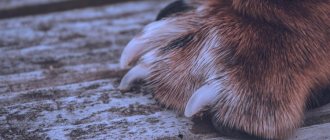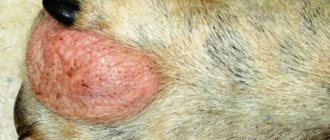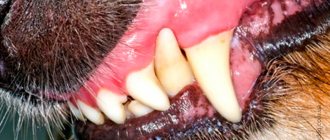Pododermatitis in dogs is an inflammatory process of the interdigital spaces or pads on the animal’s paws. It is classified as a secondary pathological sign of an autoimmune malfunction in the dog’s body. Taking into account the specifics of the onset of the disease, each case of pododermatitis must be differentiated as an individual case.
Causes of the disease
In veterinary practice, the only factor identified that precedes the development of pathology is immunodeficiency in a dog. It is believed that the disease activates the pathogenic development of bacteria living on the pet’s skin. A decrease in the protective reaction leads to their excessive vital activity.
Therefore, it is very important to quickly determine the cause of a weak immune response before the disease becomes chronic or advanced.
The main causative agents of dog pododermatitis are fleas, worms and fungal bacteria.
Factors contributing to the development of interdigital pathogenesis:
- paw mycoses;
- parasitic infestations, including mites;
- endocrine system disorders;
- autoimmune pathologies (vasculitis, lupus);
- individual intolerance;
- cancer;
- psycho-emotional instability;
- mechanical damage to the skin of the paws (cracks, injuries);
- prolonged chemical contact with the limbs of the animal.
The dog breeds most often predisposed to pododermatitis are bulldog, Pekingese, Doberman, Labrador and Shar Pei.
general information
The owner of a cheerful, cheerful and active pet suddenly notices that the dog has stopped loving to walk. During walks he limps heavily, and at home he constantly licks his paws. An external examination shows that the pads and interdigital spaces are inflamed, reddened, and the hair around them is moist. If this is the case, there is every reason to assume that the dog has pododermatitis.
Bulldogs, German shepherds, Pekingese, Shar Peis, Chow Chows, Labradors, Mastiffs, Boxers, and Bull Terriers are especially susceptible to the disease. Pododermatitis is especially difficult in overweight dogs.
Symptoms of pododermatitis in a dog
Depending on the root cause of the pathology, the disease itself differs in its individual clinical picture.
With fungal or infectious invasion, pododermatitis begins with hyperemia and swelling of the fingertips. The dog limps on his sore leg and whines. After 2-3 days, purulent ulcers appear in the affected area. The pet practically does not walk, falls heavily on the affected limb, and the dog develops a fever. In advanced forms of the disease, baldness of the affected area occurs.
The allergic history of the disease is characterized by hyperemic areas with severe itching. The pet continuously scratches its paws and tries to lick them. Crusts form on the affected areas, sticky and wet hair surrounds, and partial baldness occurs.
In cases of contact reaction, redness occurs only in a specific area of irritation. This condition is dangerous due to the development of a general allergy, with external symptoms spreading to the entire limb.
Identification of pododermatitis of autoimmune origin requires a thorough study of the cause of the disease. The clinical form of manifestation of this pathology is similar to other symptoms. Rarely, against the background of pinpoint lesions of the epidermis, thickening and darkening of the skin around the wounds is observed.
The inflammatory process of an oncological nature depends on the type of neoplasm. Against the background of developing compactions and ulcers, the general condition of the animal quickly deteriorates. The pet becomes lethargic, indifferent to what is happening, refuses food and quickly loses weight.
Swollen joint
Joint swelling in dogs is caused by developing diseases. They are hereditary and acquired.
Causes
Joints in dogs become enlarged due to the following diseases:
- arthrosis;
- purulent arthritis;
- hemarthrosis;
- hip dysplasia.
An accurate diagnosis is made by a specialist.
Symptoms
With arthrosis, the dog begins to limp, the joint becomes deformed, and pain develops.
With purulent arthritis, the temperature rises significantly, fever develops, and appetite decreases.
Hemarthrosis is accompanied by an increase in temperature, increased heart rate and respiration, and the anatomical contours of the joint are smoothed out.
Dysplasia is a disease of service dogs. Lameness, joint pain, and upward displacement of the femoral head appear.
Therapy
After a full examination, the veterinarian determines the exact cause of the enlarged joint.
Treatment is carried out in accordance with the diagnosis.
Diagnosis of pododermatitis in a dog
Timely diagnosis is the key to effective treatment. At the first signs of illness in your animal, contact your veterinarian immediately. To clarify the data and make the correct diagnosis, the doctor will prescribe the following tests:
- biopsy of affected skin areas;
- allergy tests for possible irritants;
- biochemical tests of urine and blood;
- bacterial cultures for infectious susceptibility;
- cytological examination (if cancer is suspected).
A thorough clinical examination of biological smears will allow us to determine the degree of the disease, the type of pathogen and prescribe effective therapy.
Swollen finger
The cause of this condition may be injury or an insect bite. If there are no visible lesions, tumor neoplasms are suspected.
Histiocytoma
This is a benign connective tissue tumor.
Most often it develops in cocker spaniels, bull terriers, dachshunds, boxers, terriers, great Danes, and retrievers. The disease appears as a small red ball on the paw, back, ears or head. The tumor causes itching, and the animal scratches it.
Helping the dog
The tumor should not be wetted or scratched. To do this, apply a dry bandage to the tumor or put a special collar on the animal.
Treatment
After examination, the doctor finds out whether the tumor is growing or not. If there is no cell division, hormonal therapy is prescribed.
When the tumor grows, surgical intervention is necessary.
Treatment of pododermatitis in dogs
There are no general schemes and practices here, because each specific case is purely individual, and recovery tactics depend on the clinical results over time. The faster the dog’s body gets rid of the causative agent of the disease, the more effective the treatment itself will be.
In practice, there are many cases of pets recovering when undergoing symptomatic therapy at home. However, as veterinarians warn, the disease is dangerous due to hidden relapses, so it is necessary that the animal is constantly under the supervision of a doctor during the treatment process.
Traumatic and contact dermatitis
In case of contact genesis, the affected skin should be treated with antiseptic agents (Chlorhexidine), lotions of herbal decoctions (sage or chamomile) should be applied, and ointments containing broad-spectrum antibiotics, for example, based on mupirocin, should be used.
Allergic dermatitis
It is difficult to cure, but it is possible if you can immediately identify the allergen that caused the disease. First, the doctor prescribes a strict diet for the sick animal and switches it to hypoallergenic foods.
To reduce the symptoms of itching on the paws, ointments are used that accelerate healing - Solcoseryl or Triderm. Conservative therapy includes antihistamines (Suprastin, Tavegil) and corticosteroids (Prednisolone, Dexamethosone).
Staphylococcal dermatitis
Complex treatment is used here. To begin with, the sick dog is isolated from society. A specific care regimen is established for the animal.
- regular washing of paws with soapy water;
- daily disinfection of the dog’s room and sleeping place;
- In order to prevent infection of other pets, the animal should not be allowed to go for a walk. This measure will protect the dog himself from foreign objects getting into the interdigital spaces.
To treat hyperemia and swelling in the affected areas, agents that have a drying effect are used - alum or Lysozyme. In case of severe itching, the wound can be treated with Dimexide solution (1:3 ratio of water), and an application of Novocaine can be applied at night.
For systemic skin lesions, antibacterial therapy based on 2-3 types of antibiotics, for example, tetracycline, cephalosporin and fluoroquinol groups, helps.
Aseptic (infectious) pododermatitis
Occurs as a result of inflammation of a bruise or infection of a mechanical injury to the interdigital area of the paws. Treatment of dermatitis in a dog must begin with the removal of foreign bodies that caused the infection. After this procedure, treat the wounds with an antiseptic solution (Chlorhexidine) and apply a bandage with streptocidal ointment. The dressing should be changed several times a day. As necessary, the doctor prescribes an additional course of antibiotics.
Purulent pododermatitis
The disease is classified as purulent dermatitis in cases of bacterial infection of the wound. A sick dog is prescribed a course of appropriate antibiotics until the clinical symptoms disappear and another half month after the illness to strengthen the immune response.
Autoimmune dermatitis
Due to the specificity of the causal relationships of the pathology, this disease cannot be completely cured. In order to urgently maintain the immunomodulatory level, the dog can be injected with Dexafort. This is a hormonal drug that quickly relieves signs of allergic inflammation of unknown etiology. Then the pet is prescribed more gentle hormonal therapy, for example, a course of Prednisolone.
Differential diagnosis
Thus, the specialist will always focus on those symptoms that can indicate the exact cause of what is happening to the animal. Must be taken into account: age, breed, gender
The owner is required to have as complete a medical history as possible: when, how and after what alarming signs began to appear in his pet. Various allergies (atopic dermatitis) are a more likely underlying cause if the pet is between one and five years of age, while neoplasia (especially cutaneous lymphoma) is more likely if seborrhea begins in older animals, or even middle-aged pets.
The intensity of itching plays an important diagnostic role. If it is minimal, then the animal may have some problems with the endocrine glands. Demodicosis or sebaceous adenitis is also possible. If the itching is significant, it is necessary to first consider the possibility of allergies and ectoparasites. It should be taken into account that many infections, malassezia or pyoderma also cause severe “pruritus”. Thus, the absence of itching is the first “bell” that may indicate seborrhea.
It is necessary to identify the presence/absence of polyuria, polydipsia or polyphagia (increased urination, thirst and appetite). These signs do not indicate seborrhea, but serious kidney pathologies. It is also useful to take into account the presence/absence of a dog’s pregnancy or sexual heat, that is, seasonality is important. The veterinarian should know what food and in what quantities your pet consumes, whether you are giving him corticosteroids, antibiotics, antifungals, antihistamines, etc.
In addition, it is important to take into account environmental factors (is there a possibility of the dog coming into contact with household chemicals, for example). Such a scrupulous approach to diagnosis is due, as we have repeatedly repeated, to the presence of many diseases, the clinical manifestations of which are very similar to seborrhea
Prevention
It is important to remember that pododermitis is a secondary pathology. To avoid the onset of the disease, it is necessary to adhere to preventive measures to eliminate the primary factors of the disease.
- Carry out regular inspection of your dog's skin.
- Maintain the cleanliness and hygiene of the pet, as well as its habitat in the house.
- Properly balance the animal's diet.
- Give your pet vitamin and mineral supplements with food during the period of immunodeficiency (autumn-spring).
- After a walk, inspect your pet's paws.
- During street festivities, make sure that the dog does not come into contact with stray animals.
- Conduct antiparasitic treatment and vaccination in a timely manner.
- Once a week, trim the fur between the toes.
It is important to remember that pododermatitis is a disease that is characterized by a latent course and is dangerous due to unpredictable relapses. Therefore, if the first signs of the disease appear, do not delay visiting a doctor, your pet’s life may depend on it.
Preventive measures
You need to keep an eye on your pet. After a walk, the paws should be washed and disinfected, and the hair between the toes should be trimmed.
- You need to watch what your dog eats. Nutrition should be complete and balanced.
- If your four-legged animal is kept in a kennel, you should clean it regularly.
- It is important to pay attention to any changes in behavior and, if necessary, take your pet to the clinic.
- If the cause is an allergen, it should be eliminated.
The therapy must be correct. Medicines are prescribed by a doctor, but dosages should not be exceeded. If your pet has an allergy, you should inform your veterinarian.
Currently reading:
- Thyroid dysfunction in dogs (hypothyroidism)
- Seven Signs and Remedies for Getting Rid of Fleas in Dogs
- The American Cocker Spaniel is an adroit hunter and loyal friend.
- Review for choosing carriers for small and large dogs
Care and maintenance of your pet
During treatment, it is important to provide your pet with proper care and maintenance.
- Isolate the dog from external irritants in a separate room, sufficiently warm and well ventilated.
- Constantly change the litter to avoid spreading the infection.
- Make sure to disinfect the room daily.
- Maintain hygiene of affected skin areas.
- Use a collar to prevent your pet from scratching his wounds.
- If the dog cannot be bathed, you can wipe it with a damp cloth or potassium permanganate solution.
- Follow a strict diet, feed your pet a balanced vitamin food to replenish immunodeficiency. Decoctions of herbal immunomodulators can be given as a drink.
Care, maintenance and treatment of a dog at home should be carried out under the close supervision of a veterinarian.
Symptoms of dermatitis
Common signs of the disease that appear in most cases include:
- hypermia (redness) of the affected area;
- intense itching;
- impaired hair growth, local or complete baldness;
- insomnia;
- severe swelling of the skin;
- loss of appetite or its complete absence;
- bleeding from small vessels, resulting in the formation of dried crusts;
- the formation of erosions on the surface of the epidermis and secondary wounds due to scratching the itchy area.
The disease cannot be left to chance; there is a possibility of infection, which will complicate the overall picture and may worsen the prognosis. When the first individual symptoms appear, you should contact your veterinarian.
How to treat bumps on paws?
A lump on a paw most often signals a splinter or bruise, so the first thing you need to do is carefully examine your pet’s limb. If there is a splinter, remove it and treat the wound. It’s more difficult if the splinter got deep under the skin and brought dirt there. Inflammation appears at the site, for the treatment of which a course of antibiotics is prescribed.
A lump on a paw most often signals a splinter or bruise.
Sometimes a lump on the paw can indicate much more serious problems, and their treatment will be much more difficult. The most common dog diseases are presented below.
Ingrown claws
This disease usually affects small indoor dogs that are constantly in the apartment. They don't have enough space to run, and they don't go for walks. The claws do not sharpen, like other dogs, and grow a lot. Long nails bend and stick into the pads of the paws. Purulent inflammation begins, which causes pain and a lot of inconvenience.
Ingrown claws in dogs
Table 2. What to do if the claw is ingrown?
| The claw stuck in shallowly | The claw went deep into the pad | |
| How to help your pet? | If the claw is not deeply embedded in the pad, it can be removed independently, provided that the owner already has experience in trimming claws. Its structure contains living tissue with vessels, and if you touch it with forceps, bleeding will begin | If the claw has grown too much and is stuck deep into the paw, a veterinarian will help. The owner will not be able to trim the claw without touching the pulp. Also, he will not be able to easily reach the claw: as it penetrates deeper and deeper under the skin, it touches more living tissue and gets stuck |
| Features of the procedure and care | Before the procedure, the entrance site is generously watered with Chlorhexidine, and the owner’s hands are wiped with it. Then carefully separate the tip of the stuck claw with forceps, leaving a part outside which can be used to remove the foreign body with your fingers. The claw is removed and the wound is treated with Chlorhexidine and iodine | After the doctor removes the claw, treatment of the wound is prescribed. It is regularly lubricated with antiseptic and healing ointments. If the dog tries to lick the sore paw, a loose bandage is applied. There is no need to stop the dog from playing and frolicking: the dog must be active. It is enough to regularly check the cleanliness of the wound and treat it regularly. |











